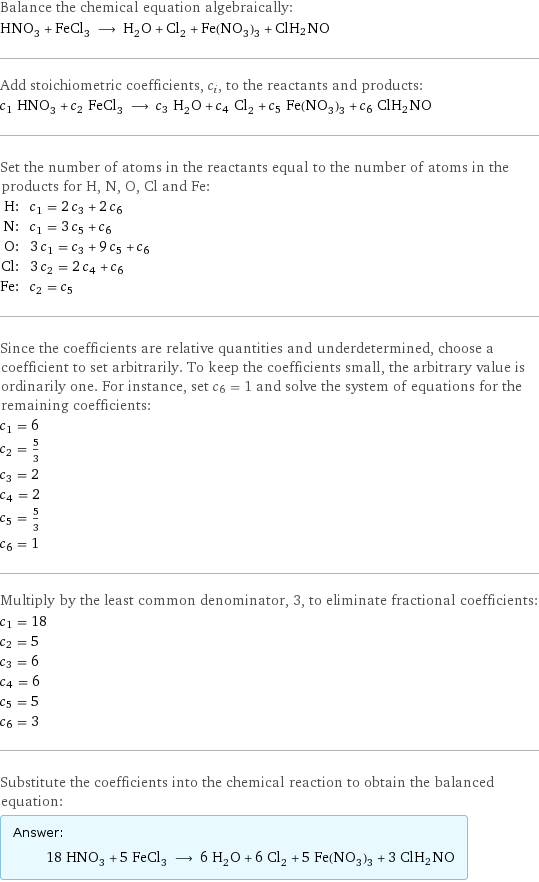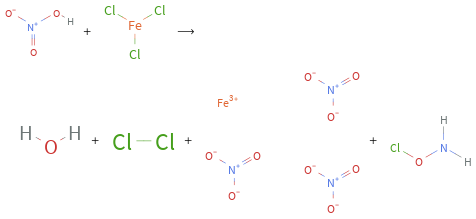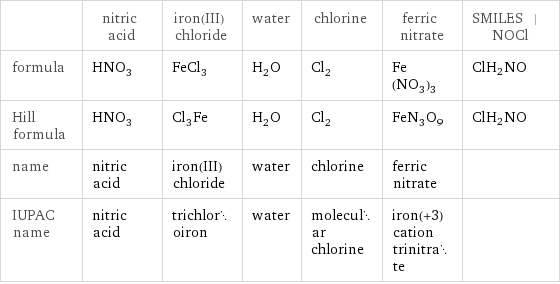Input interpretation

HNO_3 nitric acid + FeCl_3 iron(III) chloride ⟶ H_2O water + Cl_2 chlorine + Fe(NO_3)_3 ferric nitrate + ClH_2NO
Balanced equation

Balance the chemical equation algebraically: HNO_3 + FeCl_3 ⟶ H_2O + Cl_2 + Fe(NO_3)_3 + ClH_2NO Add stoichiometric coefficients, c_i, to the reactants and products: c_1 HNO_3 + c_2 FeCl_3 ⟶ c_3 H_2O + c_4 Cl_2 + c_5 Fe(NO_3)_3 + c_6 ClH_2NO Set the number of atoms in the reactants equal to the number of atoms in the products for H, N, O, Cl and Fe: H: | c_1 = 2 c_3 + 2 c_6 N: | c_1 = 3 c_5 + c_6 O: | 3 c_1 = c_3 + 9 c_5 + c_6 Cl: | 3 c_2 = 2 c_4 + c_6 Fe: | c_2 = c_5 Since the coefficients are relative quantities and underdetermined, choose a coefficient to set arbitrarily. To keep the coefficients small, the arbitrary value is ordinarily one. For instance, set c_6 = 1 and solve the system of equations for the remaining coefficients: c_1 = 6 c_2 = 5/3 c_3 = 2 c_4 = 2 c_5 = 5/3 c_6 = 1 Multiply by the least common denominator, 3, to eliminate fractional coefficients: c_1 = 18 c_2 = 5 c_3 = 6 c_4 = 6 c_5 = 5 c_6 = 3 Substitute the coefficients into the chemical reaction to obtain the balanced equation: Answer: | | 18 HNO_3 + 5 FeCl_3 ⟶ 6 H_2O + 6 Cl_2 + 5 Fe(NO_3)_3 + 3 ClH_2NO
Structures

+ ⟶ + + +
Names

nitric acid + iron(III) chloride ⟶ water + chlorine + ferric nitrate + ClH_2NO
Equilibrium constant
![Construct the equilibrium constant, K, expression for: HNO_3 + FeCl_3 ⟶ H_2O + Cl_2 + Fe(NO_3)_3 + ClH_2NO Plan: • Balance the chemical equation. • Determine the stoichiometric numbers. • Assemble the activity expression for each chemical species. • Use the activity expressions to build the equilibrium constant expression. Write the balanced chemical equation: 18 HNO_3 + 5 FeCl_3 ⟶ 6 H_2O + 6 Cl_2 + 5 Fe(NO_3)_3 + 3 ClH_2NO Assign stoichiometric numbers, ν_i, using the stoichiometric coefficients, c_i, from the balanced chemical equation in the following manner: ν_i = -c_i for reactants and ν_i = c_i for products: chemical species | c_i | ν_i HNO_3 | 18 | -18 FeCl_3 | 5 | -5 H_2O | 6 | 6 Cl_2 | 6 | 6 Fe(NO_3)_3 | 5 | 5 ClH_2NO | 3 | 3 Assemble the activity expressions accounting for the state of matter and ν_i: chemical species | c_i | ν_i | activity expression HNO_3 | 18 | -18 | ([HNO3])^(-18) FeCl_3 | 5 | -5 | ([FeCl3])^(-5) H_2O | 6 | 6 | ([H2O])^6 Cl_2 | 6 | 6 | ([Cl2])^6 Fe(NO_3)_3 | 5 | 5 | ([Fe(NO3)3])^5 ClH_2NO | 3 | 3 | ([ClH2NO])^3 The equilibrium constant symbol in the concentration basis is: K_c Mulitply the activity expressions to arrive at the K_c expression: Answer: | | K_c = ([HNO3])^(-18) ([FeCl3])^(-5) ([H2O])^6 ([Cl2])^6 ([Fe(NO3)3])^5 ([ClH2NO])^3 = (([H2O])^6 ([Cl2])^6 ([Fe(NO3)3])^5 ([ClH2NO])^3)/(([HNO3])^18 ([FeCl3])^5)](../image_source/c57360353d061130218c33b488381702.png)
Construct the equilibrium constant, K, expression for: HNO_3 + FeCl_3 ⟶ H_2O + Cl_2 + Fe(NO_3)_3 + ClH_2NO Plan: • Balance the chemical equation. • Determine the stoichiometric numbers. • Assemble the activity expression for each chemical species. • Use the activity expressions to build the equilibrium constant expression. Write the balanced chemical equation: 18 HNO_3 + 5 FeCl_3 ⟶ 6 H_2O + 6 Cl_2 + 5 Fe(NO_3)_3 + 3 ClH_2NO Assign stoichiometric numbers, ν_i, using the stoichiometric coefficients, c_i, from the balanced chemical equation in the following manner: ν_i = -c_i for reactants and ν_i = c_i for products: chemical species | c_i | ν_i HNO_3 | 18 | -18 FeCl_3 | 5 | -5 H_2O | 6 | 6 Cl_2 | 6 | 6 Fe(NO_3)_3 | 5 | 5 ClH_2NO | 3 | 3 Assemble the activity expressions accounting for the state of matter and ν_i: chemical species | c_i | ν_i | activity expression HNO_3 | 18 | -18 | ([HNO3])^(-18) FeCl_3 | 5 | -5 | ([FeCl3])^(-5) H_2O | 6 | 6 | ([H2O])^6 Cl_2 | 6 | 6 | ([Cl2])^6 Fe(NO_3)_3 | 5 | 5 | ([Fe(NO3)3])^5 ClH_2NO | 3 | 3 | ([ClH2NO])^3 The equilibrium constant symbol in the concentration basis is: K_c Mulitply the activity expressions to arrive at the K_c expression: Answer: | | K_c = ([HNO3])^(-18) ([FeCl3])^(-5) ([H2O])^6 ([Cl2])^6 ([Fe(NO3)3])^5 ([ClH2NO])^3 = (([H2O])^6 ([Cl2])^6 ([Fe(NO3)3])^5 ([ClH2NO])^3)/(([HNO3])^18 ([FeCl3])^5)
Rate of reaction
![Construct the rate of reaction expression for: HNO_3 + FeCl_3 ⟶ H_2O + Cl_2 + Fe(NO_3)_3 + ClH_2NO Plan: • Balance the chemical equation. • Determine the stoichiometric numbers. • Assemble the rate term for each chemical species. • Write the rate of reaction expression. Write the balanced chemical equation: 18 HNO_3 + 5 FeCl_3 ⟶ 6 H_2O + 6 Cl_2 + 5 Fe(NO_3)_3 + 3 ClH_2NO Assign stoichiometric numbers, ν_i, using the stoichiometric coefficients, c_i, from the balanced chemical equation in the following manner: ν_i = -c_i for reactants and ν_i = c_i for products: chemical species | c_i | ν_i HNO_3 | 18 | -18 FeCl_3 | 5 | -5 H_2O | 6 | 6 Cl_2 | 6 | 6 Fe(NO_3)_3 | 5 | 5 ClH_2NO | 3 | 3 The rate term for each chemical species, B_i, is 1/ν_i(Δ[B_i])/(Δt) where [B_i] is the amount concentration and t is time: chemical species | c_i | ν_i | rate term HNO_3 | 18 | -18 | -1/18 (Δ[HNO3])/(Δt) FeCl_3 | 5 | -5 | -1/5 (Δ[FeCl3])/(Δt) H_2O | 6 | 6 | 1/6 (Δ[H2O])/(Δt) Cl_2 | 6 | 6 | 1/6 (Δ[Cl2])/(Δt) Fe(NO_3)_3 | 5 | 5 | 1/5 (Δ[Fe(NO3)3])/(Δt) ClH_2NO | 3 | 3 | 1/3 (Δ[ClH2NO])/(Δt) (for infinitesimal rate of change, replace Δ with d) Set the rate terms equal to each other to arrive at the rate expression: Answer: | | rate = -1/18 (Δ[HNO3])/(Δt) = -1/5 (Δ[FeCl3])/(Δt) = 1/6 (Δ[H2O])/(Δt) = 1/6 (Δ[Cl2])/(Δt) = 1/5 (Δ[Fe(NO3)3])/(Δt) = 1/3 (Δ[ClH2NO])/(Δt) (assuming constant volume and no accumulation of intermediates or side products)](../image_source/d419e99adda550f1a5596d928cc07afb.png)
Construct the rate of reaction expression for: HNO_3 + FeCl_3 ⟶ H_2O + Cl_2 + Fe(NO_3)_3 + ClH_2NO Plan: • Balance the chemical equation. • Determine the stoichiometric numbers. • Assemble the rate term for each chemical species. • Write the rate of reaction expression. Write the balanced chemical equation: 18 HNO_3 + 5 FeCl_3 ⟶ 6 H_2O + 6 Cl_2 + 5 Fe(NO_3)_3 + 3 ClH_2NO Assign stoichiometric numbers, ν_i, using the stoichiometric coefficients, c_i, from the balanced chemical equation in the following manner: ν_i = -c_i for reactants and ν_i = c_i for products: chemical species | c_i | ν_i HNO_3 | 18 | -18 FeCl_3 | 5 | -5 H_2O | 6 | 6 Cl_2 | 6 | 6 Fe(NO_3)_3 | 5 | 5 ClH_2NO | 3 | 3 The rate term for each chemical species, B_i, is 1/ν_i(Δ[B_i])/(Δt) where [B_i] is the amount concentration and t is time: chemical species | c_i | ν_i | rate term HNO_3 | 18 | -18 | -1/18 (Δ[HNO3])/(Δt) FeCl_3 | 5 | -5 | -1/5 (Δ[FeCl3])/(Δt) H_2O | 6 | 6 | 1/6 (Δ[H2O])/(Δt) Cl_2 | 6 | 6 | 1/6 (Δ[Cl2])/(Δt) Fe(NO_3)_3 | 5 | 5 | 1/5 (Δ[Fe(NO3)3])/(Δt) ClH_2NO | 3 | 3 | 1/3 (Δ[ClH2NO])/(Δt) (for infinitesimal rate of change, replace Δ with d) Set the rate terms equal to each other to arrive at the rate expression: Answer: | | rate = -1/18 (Δ[HNO3])/(Δt) = -1/5 (Δ[FeCl3])/(Δt) = 1/6 (Δ[H2O])/(Δt) = 1/6 (Δ[Cl2])/(Δt) = 1/5 (Δ[Fe(NO3)3])/(Δt) = 1/3 (Δ[ClH2NO])/(Δt) (assuming constant volume and no accumulation of intermediates or side products)
Chemical names and formulas

| nitric acid | iron(III) chloride | water | chlorine | ferric nitrate | SMILES | NOCl formula | HNO_3 | FeCl_3 | H_2O | Cl_2 | Fe(NO_3)_3 | ClH_2NO Hill formula | HNO_3 | Cl_3Fe | H_2O | Cl_2 | FeN_3O_9 | ClH_2NO name | nitric acid | iron(III) chloride | water | chlorine | ferric nitrate | IUPAC name | nitric acid | trichloroiron | water | molecular chlorine | iron(+3) cation trinitrate |
Substance properties

| nitric acid | iron(III) chloride | water | chlorine | ferric nitrate | SMILES | NOCl molar mass | 63.012 g/mol | 162.2 g/mol | 18.015 g/mol | 70.9 g/mol | 241.86 g/mol | 67.47 g/mol phase | liquid (at STP) | solid (at STP) | liquid (at STP) | gas (at STP) | solid (at STP) | melting point | -41.6 °C | 304 °C | 0 °C | -101 °C | 35 °C | -47.98 °C boiling point | 83 °C | | 99.9839 °C | -34 °C | | 58.63 °C density | 1.5129 g/cm^3 | | 1 g/cm^3 | 0.003214 g/cm^3 (at 0 °C) | 1.7 g/cm^3 | solubility in water | miscible | | | | very soluble | surface tension | | | 0.0728 N/m | | | dynamic viscosity | 7.6×10^-4 Pa s (at 25 °C) | | 8.9×10^-4 Pa s (at 25 °C) | | | odor | | | odorless | | |
Units
